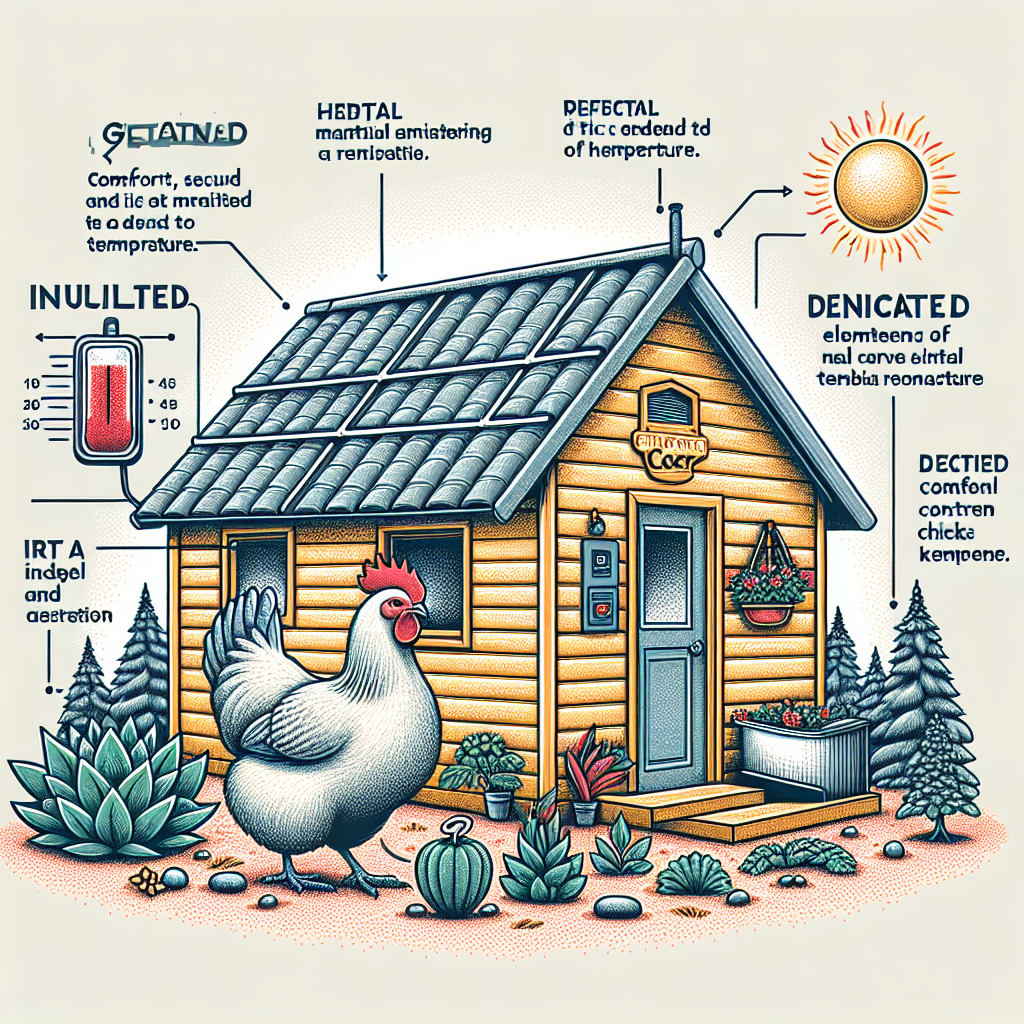When it comes to keeping your chickens happy and healthy, providing them with a safe and comfortable temperature range is crucial. But what exactly is that optimal range? Understanding the ideal temperature for your feathered friends can make a world of difference in their overall well-being. Whether you’re a seasoned chicken owner or just starting out, this article will guide you through the ideal temperature range for chickens, ensuring you can provide them with the perfect environment to thrive in.
Temperature Range for Chickens
Determining the Ideal Temperature Range
Determining the ideal temperature range for chickens is crucial to ensure their health and well-being. Chickens are sensitive creatures, and extreme temperature conditions can adversely affect their growth, egg production, and overall health. To determine the ideal temperature range, it is important to understand the biological needs of chickens and the factors that can affect their comfort and safety.
Understanding the Biological Needs of Chickens
Chickens have specific temperature requirements based on their age and stage of development. Newly hatched chicks have different temperature needs compared to adult chickens. Understanding these needs is essential to provide the right environment for their growth and ensure their overall health.
Factors Affecting Comfort and Safety
Several factors can affect the comfort and safety of chickens in relation to temperature. These factors include the ambient temperature, humidity levels, ventilation, and the presence of shade or direct sunlight. Proper management of these factors is crucial to ensure that chickens are within their preferred temperature range and avoid any adverse effects due to extreme temperatures.
Temperature Requirements for Chicks
Ideal Temperature for Newly Hatched Chicks
Newly hatched chicks require an ideal temperature of around 95°F (35°C) during their first week of life. This high temperature is necessary as they are unable to regulate their body temperature effectively during this period. It is vital to provide them with a warm and cozy environment to promote their growth and development.
Adjusting the Brooder Temperature
As the chicks grow, their temperature requirements gradually decrease. After the first week, the brooder temperature can be reduced by 5°F (3°C) per week until reaching a temperature of 70°F (21°C). This gradual decrease allows the chicks to acclimatize to lower temperatures and develop their natural ability to regulate their body temperature.
Gradual Decrease in Temperature
It is important to ensure a gradual decrease in temperature to avoid any sudden changes that could stress the chicks. Sudden drops in temperature can lead to chilling and even mortality. Regular monitoring of the brooder temperature is essential to adjust it accordingly and maintain a comfortable environment for the chicks.
Temperature Requirements for Adult Chickens
General Comfort Zone for Adult Chickens
Adult chickens have a wider temperature comfort zone compared to chicks. They generally tolerate temperatures ranging from 40°F (4°C) to 85°F (29°C). However, it is still essential to provide them with an environment within this range for optimal health and productivity.
Effects of High Temperatures
High temperatures can pose significant risks to adult chickens. When exposed to extreme heat, chickens can suffer from heat stress, dehydration, reduced egg production, and even mortality. It is crucial to take measures to prevent overheating during hot summer months, especially if your chickens do not have access to shade or sufficient ventilation.
Effects of Low Temperatures
Extreme cold temperatures also have adverse effects on chickens. When exposed to freezing temperatures, chickens may experience frostbite, reduced feed intake, decreased egg production, and susceptibility to respiratory illnesses. Providing adequate warmth and protection from freezing temperatures is crucial to ensure the well-being of adult chickens during colder months.
Managing Temperature in Different Seasons
Summertime Considerations
During the summertime, it is essential to take extra precautions to keep the chickens cool and comfortable. Providing shade is crucial to protect them from direct sunlight and high temperatures. Ensuring proper ventilation in the coop allows hot air to escape and cooler air to circulate, preventing heat buildup. Additionally, offering cool treats like frozen fruits or vegetables can help chickens stay hydrated and regulate their body temperature.
Winter Precautions
In colder months, it is important to provide sufficient warmth and insulation for chickens. Insulating the chicken coop helps retain heat and protects chickens from the cold. Using heating devices such as heat lamps or heaters can provide additional warmth if needed. Regularly checking for drafts and sealing any gaps or cracks in the coop prevents cold air from entering and maintains a comfortable environment for the chickens.
Providing Adequate Ventilation
Importance of Ventilation for Temperature Regulation
Proper ventilation in the chicken coop is crucial to maintain an optimal temperature for the chickens. Ventilation helps remove excess moisture, ammonia, and stale air, preventing respiratory issues and maintaining a healthy living environment. It also helps regulate the temperature by allowing fresh air to circulate, preventing heat buildup during hot weather.
Ventilation Guidelines for All Seasons
Ventilation should be provided throughout the year, regardless of the season. In warmer months, ventilation helps remove hot and humid air, while in cooler months, it prevents condensation and moisture buildup. It is important to strike a balance between providing adequate ventilation and avoiding drafts, as excessive drafts can make the chickens uncomfortable and susceptible to respiratory issues.
Utilizing Heat Lamps and Heaters
Choosing the Right Heat Source
When additional heat is required, especially for newly hatched chicks or during cold winter months, choosing the right heat source is crucial. Heat lamps or radiant heaters are commonly used to provide warmth. It is important to select heat sources designed for poultry use, ensuring safety and efficiency. Always follow the manufacturer’s instructions for installation and operation.
Placing Heat Lamps or Heaters
Heat lamps or heaters should be placed at a safe distance from flammable materials and should not be in direct contact with the chickens. They should also be positioned in a way that provides a warm zone for the chickens without creating excessive heat that could lead to overheating or dryness. Regularly monitoring the temperature and adjusting the heat source accordingly is essential to maintain a comfortable environment.
Monitoring Temperature Levels
Regularly monitoring the temperature levels in the chicken coop is crucial to ensure the chickens’ comfort and well-being. Using thermometers placed at chicken height and in different areas of the coop helps accurately gauge the temperature. This allows for timely adjustments to the heat source or ventilation to maintain the desired temperature range.
Insulating the Chicken Coop
Benefits of Proper Insulation
Proper insulation of the chicken coop provides various benefits, especially during extreme temperatures. Insulation helps retain heat during colder months, reducing the need for additional heating devices. It also prevents excessive heat buildup during hot weather, allowing the chickens to stay cool. Insulation contributes to a stable and comfortable environment for the chickens throughout the year.
Recommended Insulation Materials
There are various insulation materials suitable for chicken coops. Common options include fiberglass insulation, foam board insulation, and reflective insulation. Each material has its advantages and disadvantages, so it is important to consider factors such as cost, effectiveness, and ease of installation when selecting the appropriate insulation for your chicken coop.
Monitoring Temperature Levels
Using Thermometers
Using thermometers is a reliable way to monitor temperature levels in the chicken coop. Digital thermometers or wireless devices that provide real-time temperature readings are especially useful. Placing them at chicken height and in different areas of the coop allows for accurate assessment of the temperature throughout the space where the chickens reside.
Regularly Checking on Chickens
While thermometers provide valuable information, it is also important to regularly check on the chickens themselves. Observing their behavior and overall well-being can give an indication of whether they are comfortable or experiencing temperature-related stress. Signs of temperature-related discomfort include excessive panting, lethargy, huddling together, or seeking shade excessively.
Additional Measures to Ensure Comfort
Providing Access to Shade and Sunlight
Chickens benefit from access to both shade and sunlight. During hot weather, providing shade helps protect them from direct sunlight and keeps them cool. On the other hand, allowing them access to sunlight promotes their well-being and encourages natural behaviors. Ensuring a balance between shade and sunlight is essential to meet their needs and maintain their overall comfort.
Preventing Drafts
While ventilation is necessary, it is important to prevent drafts in the chicken coop. Drafts can make the chickens uncomfortable and increase the risk of respiratory issues. Regularly checking for any gaps, cracks, or areas where drafts may occur, and sealing them with appropriate materials helps maintain a draft-free environment and ensures the chickens’ comfort.
Conclusion
Maintaining the right temperature range for chickens is essential for their overall health and well-being. Understanding their temperature requirements based on their age, monitoring temperature levels, providing adequate ventilation, and taking appropriate measures in different seasons are key to creating a comfortable environment for them. By following these guidelines and regularly assessing their comfort, you can ensure that your chickens thrive and lead happy, healthy lives.




